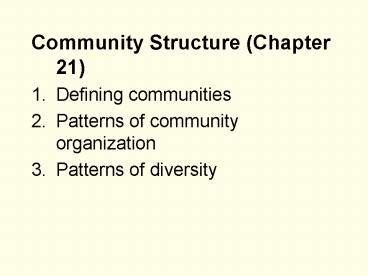Community Structure (Chapter 21) - PowerPoint PPT Presentation
1 / 30
Title:
Community Structure (Chapter 21)
Description:
Because there are so many species, it's useful to group species by ... woodpeckers, squirrels, raccoons, wasps, bees, ants, snakes... Why are guilds useful? ... – PowerPoint PPT presentation
Number of Views:50
Avg rating:3.0/5.0
Title: Community Structure (Chapter 21)
1
- Community Structure (Chapter 21)
- Defining communities
- Patterns of community organization
- Patterns of diversity
2
- Community association of interacting
populations - Different ways that communities are organized
3
- Because there are so many species, its useful to
group species by how they use resources - Guild group of species that use resources in a
similar way
4
- Types of guilds
- foraging use the same food resources or feed in
the same locations - nesting reproduce in the same places
- Guilds can include diverse, unrelated species
- seed-eating animals in the desert
- ants, rodents, birds
- cavity-nesting animals in forest
- woodpeckers, squirrels, raccoons, wasps, bees,
ants, snakes
5
- Why are guilds useful?
- simplifies analysis of communities
- a few guilds vs. 1000s of species
- allows comparison across locations
- organisms that use the same resources will
respond to environmental changes in similar ways
6
- Biome community type distinguished by dominant
plant form - Ecotone a zone of transition between two
habitat types
7
Sharp ecotone
Soft ecotone
8
- Ecotones are often caused by underlying
environmental gradients
9
(No Transcript)
10
- Ecotones often have more species than either of
the two habitats does alone - Some species are specifically adapted to edge
conditions - Ecotones are maintained by plants themselves,
fire, or competition
11
(No Transcript)
12
- Two ways of looking at a community
- Holistic view
- species in a community act as a superorganism,
coevolved to act as one unit - can only understand the community by
understanding the species together, not
separately - distributions of species in a community coincide
13
- Two ways of looking at a community
- Individualistic view
- communities are aggregations of populations that
happen to be in the same place - each population has its own independent dynamics
- distributions of species are individualistic, in
response to environmental conditions
14
- Holistic view leads to the idea of a closed
community one in which each species
distribution coincides with the boundaries of the
community - Individualistic view leads to the open community
concept each species has its own limits, so the
boundaries of a community are abitrary
15
(No Transcript)
16
- The continuum concept
- Ecotones tend to be soft, with overlap between
communities across the ecotone - Distributions of plant species tend to be
independent of one another
17
(No Transcript)
18
- The continuum concept is the idea that plant and
animal species continually replace each other
along environmental gradients - temperature
- precipitation
- soil types
- soil moisture
19
(No Transcript)
20
(No Transcript)
21
(No Transcript)
22
- Within any community species differ in how
abundant they are
23
- For any different type of organism in a community
- a few species will be very abundant (dominant
species) - most species will be relatively rare
24
- Diversity
- Diversity the variety of taxa in a particular
place - Species richness the number of species in a
community - varies widely from place to place
- can be very high in some locations
25
(No Transcript)
26
- Because species can differ in abundance, richness
may be a poor measure of diversity - Evenness how evenly abundances are distributed
among species
27
(No Transcript)
28
- Two diversity indices that account for evenness
- Simpsons index
- pi the proportional abundance of species
- (count of species i)/(total sample
size) - varies from 1 to S (the species richness)
- larger numbers indicate more diversity
29
- Two diversity indices that account for evenness
- Shannon-Wiener Index
- pi the proportional abundance of species i
- maximum ln (S)
- larger numbers indicate more diversity
- often reported as eH
30
(No Transcript)































